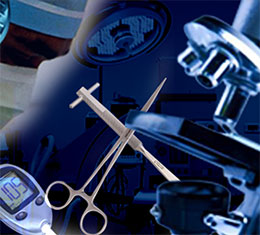Medical Devices – Made In India

Rajiv Nath
Forum Coordinator, Association of Indian Medical Device Industry (AIMED)
Made-in-India medical devices are a possibility now if the government helps make the sector viable and addresses the adverse duty structure, informs Rajiv Nath, Forum Coordinator, Association of Indian Medical Device Industry (AIMED), in a tete-e-tete with Prathiba Raju of Elets News Network (ENN)
How will the upcoming medical device park help the device industry?

We should focus on appropriate eco system for import substitution of Rs 22,000 crores of imports, to enable the vision of Make in India. India is 90 per cent import dependent when it comes to medical products alone. India’s import dependency on high-end medical devices is over 80 per cent. In order to be import independent, we need favorable policies and innovative ideas. For example the two upcoming medical device parks in Andhra Pradesh and Nagpur (Maharashtra) would be of great value as they will reduce the import dependency, increasing export while generating wealth and employment within. If favorable policies are in place we can be a hub of medical device as well. In terms of investment for each industrial park it might be about 200 to 500 crores. The medical device parks aims to create an ecosystem which will be interdependent and create policies which allow local manufacturing to thrive. With such high import dependency, the country needs favorable policies and on the ground ecosystem to allow manufacturing of medical devices which require higher technology, inputs, raw materials and consumables.

And, how about the medical device park in Andhra Pradesh?
The project of medical device park in Andhra Pradesh has been approved by the State cabinet. Once the site project is approved and post discussion among senior bureaucrats in AP government, suggestions will be sought and put into implementation. We expect the project to be operational in two to three years.

Can your share the details of the upcoming Nagpur medical device park?

A delegation already visited Nagpurand reviewed the project. A report and recommendation would be given to the Maharashtra government. AIMED as already suggested not to repeat the same product line of Andhra Pradesh of electronic and software, as AP has that kind of industry around they can cater to them. Nagpur can have more hard technology implants, which are not made in India. The industrial park is practically ready as they have the infrastructure at place. It needs just some additional facilities so it can be ready within a year and it can actually overtake the Andhra Pradesh Park. There are seven product verticals in medical devices the consumables, disposables, electronics, equipments, implants, diagnostic reagents and surgical instruments we have recommended that concentrate on couple of segments, so common eco friendly system can exist.
What are the exclusive features of these medical device parks?
What we have recommended to AP and Maharashtra government is that they need to have a cluster approach around common manufacturing facilitation hub. The hub can have ethane oxide gas sterilisation plant, a hard technology laboratory tool room for doing various kinds of moulds. Both the parks will be spanning across 200 acres.
Can you brief us about the medical device clusters in our country? How the parks will compliment them?
 Currently five existing clusters of manufacturing device existing in the country Delhi-NCR belt has more high volume hard technology disposables; Ahmedabad has more of disposables low technology, orthopedic implants and stents, Mumbai Pune is electronic and diagnostic industry oriented and Bangalore and Chennai are electronic and equipment oriented. We have recommended to the government to build upon the existing clusters and the park can connect all the five clusters.
Currently five existing clusters of manufacturing device existing in the country Delhi-NCR belt has more high volume hard technology disposables; Ahmedabad has more of disposables low technology, orthopedic implants and stents, Mumbai Pune is electronic and diagnostic industry oriented and Bangalore and Chennai are electronic and equipment oriented. We have recommended to the government to build upon the existing clusters and the park can connect all the five clusters.
The department of pharmaceuticals has already created a task force for the medical device which came out with a report. The task force has drafted a medical device policy and its with the Prime Minister Office (PMO) for a release. In that draft medical device policy has recommendation that such park is necessary. The parks can have a common manufacturing facility and then a cluster of SME can be created around this. For example to come up with a high end technology facility it will be costing Rs 40 crore and small companies cant invest. So such medical device park can help and benefit the SMEs.
What are the advantages of producing Made-in-India medical devices?
If manufacturing happens locally and if the manufacturers are able to give price commitment for two years, it will allow public healthcare to buy large volume goods at competitive prices for over a period of time. Made in Indias medical device demand will grow. Not just domestic products, but if a manufacturer takes steps to meet the local markets requirements like quality, price competitiveness; they can be automatically competitive in the export market. The current exports in the segment are US $1.2 billion. When compared to China, the medical device in India is able to compete on quality and technology and able to demand a price utilisation nearly 30 per cent higher than China in the international market. Chinese Government has been very aggressive and are giving 17 per cent subsidy to export of medical device and in India what is given differs by just two to three per cent, which is miniscule.
For India to be import-independent, the government should increase the import duty to 10 per cent and keep lower duty on the raw materials. Currently, its the other way round where the peak duty is on raw materials and minimal duty is on the finished devices
How important is the national policy on medical device?
The policy is very important because if the policy does not take shape, these parks will be green parks. An industrial park cannot sell on its own as this is not real estate asset. For India to be import independent, government should increase the import duty to 10 per cent and keep lower duty on the raw materials. Currently its the other way around where the peak duty is on raw materials and minimal duty is on the finished devices. Huge requirements for import substitution then the flood gates will open to start manufacturing in India. We have incorrect and incomplete regulations of Drug and Cosmetics Act and apply only to 22 devices; a proper set of regulations is needed.
post_id:uld_count:
Cookie not set
Value 1: 0
Value 2: 10















